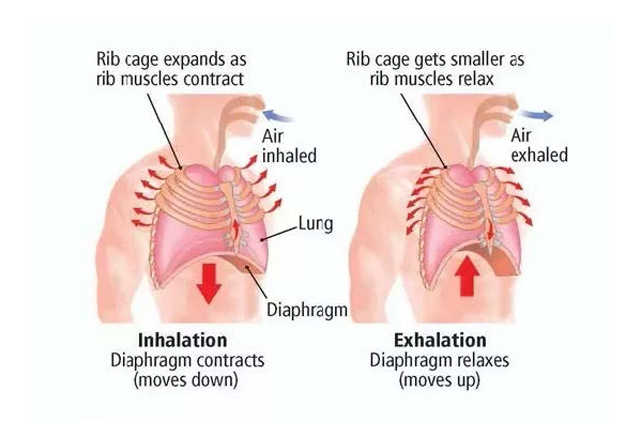Breathing Techniques
Breathing Control

Breathing control is about the best use of your main breathing muscle - your diaphragm. The focus is on reducing tension and using your shoulder and neck muscles to get into the best position for you to breathe easily. Your diaphragm contracts when you breathe. This pulls the lungs down, stretching and expanding them. It relaxes back – into a dome position – when you breathe out, reducing the amount of air in your lungs.
"What has to be taught first, is the breath."
-- Confucius
Belly Breathing (Diaphragmatic Breathing)
Diaphragmatic breathing helps strengthen the diaphragm, decrease the work of breathing by slowing your breathing rate, and decrease oxygen demand.
- Sit or lie in a comfortable place.
- Place one hand on your chest and one hand on your abdomen. The bottom hand should do the moving. The top hand should remain still.
- Inhale through your nose for about 4 seconds, feeling your abdomen expand.
- Hold your breath for 2 seconds.
- Exhale very slowly and steadily through your mouth for about 6 seconds.

Pursed Lip Breathing
Pursed lip breathing slows your breathing pace, making each breath more effective. It also helps you get more oxygen into your lungs.
- Inhale slowly through your nose for two seconds with your mouth closed. You don’t need to take a deep breath; a normal breath is OK.
- Purse (pucker) your lips as though you’re going to whistle.
- Exhale slowly and gently through your pursed lips for four or more seconds. It may be helpful to count to yourself.

Blow As You Go Breathing
Blow as you go breathing (aka coordinated breathing) helps make tasks and activities easier. Use it while you’re doing something that makes you breathless. You can use it with pursed-lips breathing.
- Breathe in before you make the effort.
- Then breathe out while you’re making the effort. For example, when standing up, breathe in before you step or standup, and then blow out as you stand up.

Positions to Help You Recover From Breathlessness
Sit Leaning Forward


Stand Leaning Forward
Lean from the hips, with your forearms resting on something at the right height, such as a chair or kitchen work surface.

High Side Lying
Lie on your side with pillows under your head and shoulders. Make sure your top pillow supports your neck. Slightly bend your knees, hips and top leg.

Stand Leaning Backwards or Sideways Against a Wall
Have your feet slightly apart. Relax your hands down by your sides. If you prefer, rest your hands or thumbs in your waistband or belt loops, or across the shoulder strap of your handbag.

